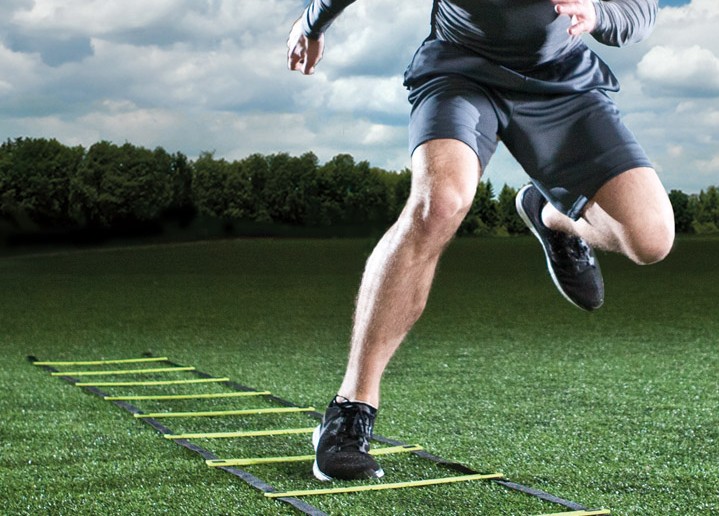Hamstring injuries are a reality for sprinting athletes. Many experts today think this is due to the strength, or lack thereof, of the hamstrings while in the lengthened position especially during one phase of the sprinting action. When sprinting, the foot leaves the ground. The foot is then brought up to the athlete’s hip. From here, the leg is swung forward. As this is done, the foot uncouples from the hip. The lengthened leg is then driven to the ground. The thinking is that the period when the foot is uncoupling and being driven to the ground is where a lot of these injuries are occurring. During this phase, the hamstring is firing eccentrically to prevent the knee from hyperextending while it is also being asked to shorten in order to extend the hip (i.e. drive the foot to the ground).
A coach has four tools to help prevent these injuries in sprinting athletes:
1. Warm-up drills
2. Sprinting drills
3. Hamstring strengthening exercises
4. Eccentric exercises
Warm-up drills are a combination of mobility exercises and calisthenics that can help to address the hamstrings. These include different kinds of leg swings, marches (straight leg, use the hip, focus on a tall body and lifting the leg high); exercises like walk forward on straight legs, touch the right hand to the left foot, step with the left foot, touch the right hand to the left foot, etc., crab walks, and inchworms. Each of these could be started with ten meter distances and gradually increased as the athlete progresses.
Sprinting drills develop parts of the sprinting motion and basically continue the warming up process. They have the benefit of strengthening the hamstrings using the motion that we’re trying to prepare them for. Some of these include A drills (which attempt to duplicate the sprinting motion), B drills (which exaggerate the phase of the sprint that we are concerned with), and exaggerating straight leg bounds to focus on pulling the hips forward. Again, these can be done for ten meter distances and gradually increased as the athlete progresses.
With regards to strengthening the hamstrings in the weight room, first the lower body needs to be strong. This means squats and deadlifts. Don’t overlook lunges and split squats for this role, while not as sexy as heavy squats/deadlifts they also do an awesome job of taxing the hamstrings.
I’m a firm believer in avoiding leg curls for sprinting athletes. While they do an awesome job of making the hamstrings a lot bigger, in my experience they have a tendency to shorten those muscles as well – which is a problem for a sprinting athlete. I prefer exercises that strengthen the hamstrings in the lengthened position and really focus on hip extension. This means Romanian deadlifts, all types of good mornings, all types of back raises, reverse hypers, glute ham raises, that sort of thing.
Finally, more advanced athletes need to incorporate exercises that focus on eccentric strength. This could be as simple as pausing at the bottom of a squat, exaggerating the descent in a Romanian deadlift (i.e. take ten slow seconds to descend), or it could involve incorporating exercises like the Nordic hamstring exercise.
You don’t need to do everything in every workout. Below are some thoughts on how to do this based upon the athlete’s level of ability:
|
High School |
College |
Elite |
|
|
Sprinting Warm-Up |
1-2 hamstring exercises |
3-4 hamstring exercises |
3-4 hamstring exercises |
|
Sprinting Workout |
1 drill |
1-2 drills |
2-3 drills |
|
Strength Training |
Squats/Deadlifts 1 hip extension exercise |
Squats/Deadlifts Lunges/Split Squats 1 hip extension exercise |
Squats/Deadlifts Lunges/Split Squats 1 hip extension exercise 1 one-legged hip extension exercise |
|
Eccentric Exercises |
N/A |
N/A to maybe 1 |
1 |
Below is a sample workout for a high school sprinting athlete, using the above guidelines. Basically this is a good, foundational workout:
|
Speed Workout |
Strength Training Workout |
|
Warm-Up: Light jog, 400 meters Walk on toes, 2×20 meters Leg swings, 2×20 March, 2×20 meters Butt kicks, 2×20 meters High knee walk, 2×20 meters High knee skip, 2×20 meters Sprinting workout: Straight leg bounds (exaggerated), 3×20 meters Fast leg drills, 2×20 meters Stride length drills, 2×20 meters Sprints |
Back squats, 3-5×8-12×70-80% Romanian deadlifts, 3-5×8-12 Bench press, 3-5×8-12×70-80% Bent-over rows, 3-5×8-12 Military press, 3-5×8-12 |
Below is an example of how this could progress for an experienced collegiate athlete. As you can see, the volume is greater and the workout is a little more specialized as the athlete progresses:
|
Speed Workout |
Strength Training Workout |
|
Warm-up: Light jog, 400 meters Walk on toes, 2×20 meters Leg swings, 2×20 Eagles/Stomach eagles, 2×20 March, 2×40 meters Inchworms, 2×40 meters Butt kicks, 2×40 meters High knee walk, 2×40 meters Lunges, 2×20 meters High knee skip, 2×40 meters Sprinting workout: Straight leg bounds (exaggerated), 3×40 meters A walks, 3×40 meters Fast leg drills, 2×20 meters Stride length drills, 2×20 meters Sprints |
Power clean, 3-5×3-4×60-70% Clean pulls, 3x6x70% Back squats, 3-5×8-12×70-80% Lunges, 3-5×8-12 each leg Good mornings, 3×8-12 Reverse hypers, 3×15-20 Nordic hamstring, 3×5
|
Hamstrings need to be a focus for sprinting athletes on the track and in the weightroom. Not only does this prevent hamstring pulls, but this is also a good idea for ACL injury prevention.




